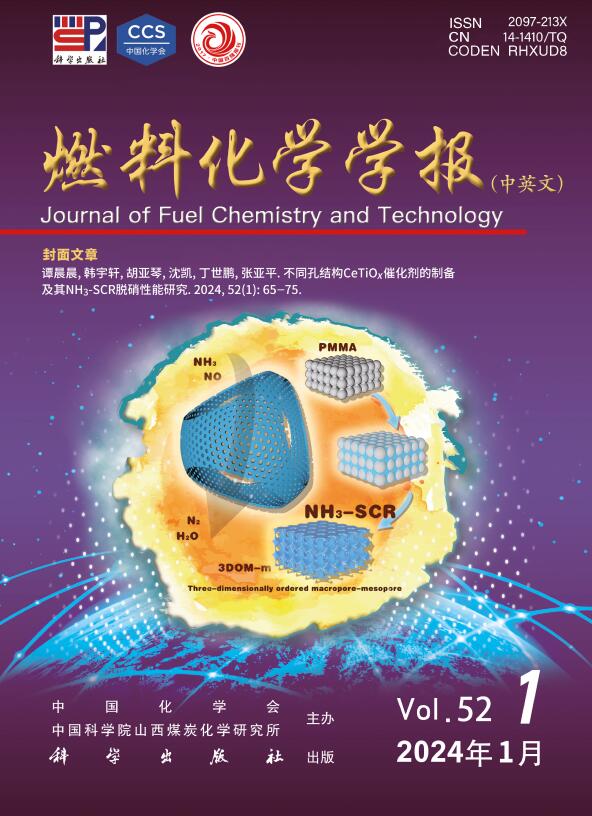The role of Gd2O3 in Pt-based sulfur-resistant catalysts for CO oxidation
Q3 Energy
引用次数: 0
Abstract
The present study investigates the preparation and characterization of three catalysts (1%Pt/CZLY, 1%Pt/CZLGd and 1%Pt/CZLYGd) using the polyol method. The results reveal that the addition of gadolinium elements (Gd) to the catalysts leads to an enhancement in the specific surface area. This is attributed to the Ce3+ species promotion and Olatt formation, facilitated by the presence of Gd. Furthermore, the action of Gd results in the formation of smaller and more uniformly dispersed Pt particles. The 1%Pt/CZLYGd catalyst displayed the most exceptional CO catalytic oxidation activity (t90 = 95 °C, GHSV = 45000 mL/(g·h)), demonstrating its durability for 24 h. Additionally, it exhibited notable resistance to the toxicity of SO2. The interaction of Gd2O3 with other components has the potential to enhance the number and variety of active sites, thereby improving the catalytic efficiency and enhancing the thermal stability and sulfur resistance of the catalyst, thus extending its service life. This provides a novel concept for the development of high sulfur-resistant catalysts for industrial applications.
Gd2O3在pt基耐硫CO氧化催化剂中的作用
采用多元醇法制备了1%Pt/CZLY、1%Pt/CZLGd和1%Pt/CZLYGd三种催化剂,并对其进行了表征。结果表明,在催化剂中添加钆元素(Gd)可以提高催化剂的比表面积。这是由于Gd的存在促进了Ce3+的形成和Olatt的形成。此外,Gd的作用导致形成更小、更均匀分散的Pt颗粒。1%Pt/CZLYGd催化剂表现出最优异的CO催化氧化活性(t90 = 95°C, GHSV = 45000 mL/(g·h)),并表现出24 h的耐久性。此外,它还表现出明显的抗SO2毒性。Gd2O3与其他组分的相互作用有可能增加活性位点的数量和种类,从而提高催化效率,增强催化剂的热稳定性和抗硫性,从而延长其使用寿命。这为工业应用的高耐硫催化剂的开发提供了一个新的概念。
本文章由计算机程序翻译,如有差异,请以英文原文为准。
求助全文
约1分钟内获得全文
求助全文
来源期刊

燃料化学学报
Chemical Engineering-Chemical Engineering (all)
CiteScore
2.80
自引率
0.00%
发文量
5825
期刊介绍:
Journal of Fuel Chemistry and Technology (Ranliao Huaxue Xuebao) is a Chinese Academy of Sciences(CAS) journal started in 1956, sponsored by the Chinese Chemical Society and the Institute of Coal Chemistry, Chinese Academy of Sciences(CAS). The journal is published bimonthly by Science Press in China and widely distributed in about 20 countries. Journal of Fuel Chemistry and Technology publishes reports of both basic and applied research in the chemistry and chemical engineering of many energy sources, including that involved in the nature, processing and utilization of coal, petroleum, oil shale, natural gas, biomass and synfuels, as well as related subjects of increasing interest such as C1 chemistry, pollutions control and new catalytic materials. Types of publications include original research articles, short communications, research notes and reviews. Both domestic and international contributors are welcome. Manuscripts written in Chinese or English will be accepted. Additional English titles, abstracts and key words should be included in Chinese manuscripts. All manuscripts are subject to critical review by the editorial committee, which is composed of about 10 foreign and 50 Chinese experts in fuel science. Journal of Fuel Chemistry and Technology has been a source of primary research work in fuel chemistry as a Chinese core scientific periodical.
 求助内容:
求助内容: 应助结果提醒方式:
应助结果提醒方式:


